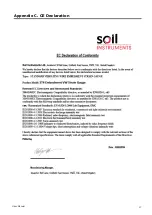
User Manual
14
Section 9 :
Troubleshooting Guide
If a failure of any vibrating wire transducer or its electrical cable is suspected, the following steps can
be followed. The transducers themselves are sealed and cannot be opened for inspection. The
“Troubleshooting Flowchart” should also be followed if any instrument failures are suspected.
The steps below and the Troubleshooting Flowchart are applicable generally to any vibrating wire
instrument.
Step 1
Before any of the following steps are followed, the readout unit should be used to verify the stability of
the reading and the audio signal from the portable logger should be heard. The period reading from
the transducer should not vary by more than ± 3 units and the audio signal should be crisp and of a
consistent tone and duration. An unstable (wildly fluctuating) reading from a transducer or an
unsteady audio signal are both indications of possible problems with instruments, or their related
electrical cables.
Important
: If a portable data logger is giving faulty readings or audio signals from all transducers, a
faulty readout unit must be suspected. Another readout unit should be used to check the readings
from the transducers and Soil Instruments Ltd should be consulted about the faulty readout unit.
Before proceeding to Steps 2 and 3, if possible the continuity should be checked between conductors
and earthing screen of the electrical cable. If continuity exists, a damaged cable is confirmed.
Step 2
The resistance across the two conductors of the electrical cable should be checked. This can be done
using a multimeter device across the two exposed conductors if the cable has not been connected to a
terminal cabinet, or can be done just as easily across the two conductors if the instrument has been
connected to such a terminal (or Data Loggers).
The resistance across the two conductors should be approximately of the order of 80
to 180
. The
majority of these resistances arise from the transducer and the remainder from the electrical cable
connected to the transducer.
Step 3
If the resistance across the two conductors is much higher than the values quoted in “Step 2” (or is
infinite), a damaged cable must be suspected.
Step 4
If the resistance across the two conductors is much lower than the values quoted in “Step 1” (say 80
or less) it is likely that cable damage has occurred causing a short in the circuit.
Step 5
If the resistance is within the values quoted in “Step 1” (i.e. 80
to 180
), AND no continuity exists
between conductor and earth screen and on checking the reading from the transducer, it proves to be
still unstable or wildly fluctuating, it must be assumed that the integrity of the circuit is good. A faulty
transducer must be suspected and Soil Instruments Ltd should be consulted.
TIP
If the location on site of cable damage is found, the cable can be spliced in accordance with
recommended procedure with suitably qualified personnel.
Summary of Contents for 1030
Page 17: ...User Manual 17 Appendix C CE Declaration ...
Page 18: ...User Manual 18 ...
Page 19: ...User Manual 19 ...






































